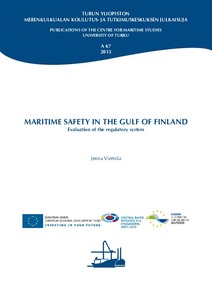Maritime Safety in the Gulf of Finland: Evaluation of the Regulatory System
Viertola Jenna
Maritime Safety in the Gulf of Finland: Evaluation of the Regulatory System
Viertola Jenna
University of Turku, Centre for Maritime Studies
Julkaisun pysyvä osoite on:
https://urn.fi/URN:NBN:fi-fe2021042714609
https://urn.fi/URN:NBN:fi-fe2021042714609
Tiivistelmä
Growing traffic is believed to increase the risk of an accident in the Gulf of Finland. As the consequences of a large oil accident would be devastating in the vulnerable sea area, accident prevention is performed at the international, regional and national levels. Activities of shipping companies are governed with maritime safety policy instruments,
which can be categorised into regulatory, economic and information instruments. The maritime regulatory system has been criticised for being inefficient because it has not been able to eliminate the violations that enable accidents.
This report aims to discover how maritime governance systems or maritime safety policy instruments could be made more efficient in the future, in order to improve the maritime safety level. The results of the research are based on a literature review and nine expert interviews, with participants from shipping companies, interest groups and
authorities.
Based on the literature and the interviews, a suggestion can be made that in the future, instead of implementing new policy instruments, maritime safety risks should be eliminated by making the existing system more efficient and by influencing shipping companies’ safety culture and seafarers’ safety related attitudes. Based on this research, it can be stated that the development of maritime safety policy instruments should concentrate on harmonisation, automation and increasing national and cross-border cooperation. These three tasks could be primarily accomplished by developing the existing technology.
Human error plays a role in a significant number of maritime accidents. Because of this, improving companies’ safety culture and voluntary activities that go beyond laws are acknowledged as potential ways of improving maritime safety. In the future, maritime regulatory system should be developed intoa direction where the private sector has better possibilities to take part in decision-making.
Based on the literature and the interviews, a suggestion can be made that in the future, instead of implementing new policy instruments, maritime safety risks should be eliminated by making the existing system more efficient and by influencing shipping companies’ safety culture and seafarers’ safety related attitudes. Based on this research, it can be stated that the development of maritime safety policy instruments should concentrate on harmonisation, automation and increasing national and cross-border cooperation. These three tasks could be primarily accomplished by developing the existing technology.
Human error plays a role in a significant number of maritime accidents. Because of this, improving companies’ safety culture and voluntary activities that go beyond laws are acknowledged as potential ways of improving maritime safety. In the future, maritime regulatory system should be developed intoa direction where the private sector has better possibilities to take part in decision-making.
Kokoelmat
- Rinnakkaistallenteet [27094]
